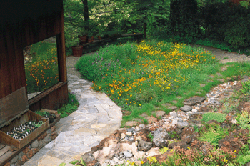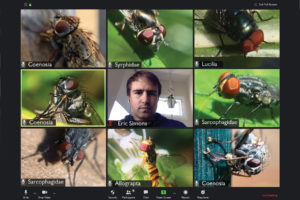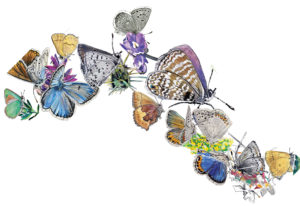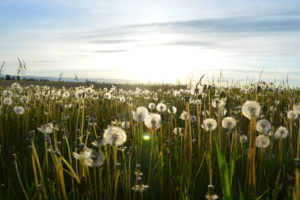My backyard is nothing to boast about, with its clumps of grass and sprawling blackberry canes. So I was surprised when a flock of white-crowned sparrows came to visit. As they scratched in the dirt for grass seed, I began to notice golden-crowned sparrows and towhees as well, and a scrub jay pounding acorns into the ground. What I had seen as barren called to these birds as a haven of sorts.
The sparrows returned for several days and then were gone. Where did they go? In my mind’s eye I traveled with them as they flew up over my neighbor’s manicured lawn, above the streets and shopping centers, in search of other lots like mine. I imagined looking down on this mosaic as a white-crowned sparrow might, and I marveled at how much habitat for wildlife remains in our densely inhabited landscape.
A Quilt of Backyard Habitats
In the Bay Area’s residential areas, 20 to 60 percent of the land remains open—it has not yet been sealed by paving or covered by structures—and every bit is potential habitat. Wherever there’s soil and air, organisms are making a living: Fungi and bacteria silently go about the business of energy conversion, insects hunt and pollinate, plants extend roots downward and stems upward, and winged creatures—or furry or skin-breathing ones—eat and sleep. Habitat doesn’t only mean parks and undeveloped lands; it also means backyards and front yards and side yards and median strips. It even means gardens of potted plants.
Habitat means different things to different creatures. For one kind of lichen, it can mean a patch of concrete. For the Anna’s hummingbird that visited where I used to live, habitat meant a willow tree to nest in and nectar from California bee plants. Almost any red flower will attract a flexible feeder like the Anna’s hummer, but California bee plant supports a host of other species as well. As a native of coastal California, its rich interactions with local wildlife have evolved over thousands of years.
- A native bunchgrass meadow in the Berkeley hills, with California poppy (Eschscholzia californica), Chinese houses (Collinsia heterophylla), and buttercups (Ranunculus californicus). Photo by Saxon Holt.
In my new yard, I had inadvertently created habitat for seed-eating sparrows simply by neglecting to mow. I began to wonder what I might accomplish if I purposely tried to bring wildlife to the yard, and I began to think about the larger habitat that might be created if my neighbors became wildlife gardeners as well. With care and attention, these patches of land could become refuges, little havens of biodiversity. Pieced together, they might make a crazy quilt of not-quite-wilderness that provides far more habitat than will ever be preserved as public open space.
And what’s inviting to wildlife, of course, also benefits the broader environment. Anna’s hummingbirds rely not only on nectar but also on small insects for nourishment; if you permit the presence of a few aphids because they make good bird food, then you probably won’t have to use pesticides. If you plant locally appropriate native plants because you want to attract a greater variety of animals, you can skip the fertilizers because these plants don’t need them. And since many natives are drought tolerant, you’ll be conserving water too, a significant step when you consider that more than 50 percent of the water used by residences in the Bay Area is applied outdoors. So indeed, the choices we make in our yard—whether it’s a half acre or a three-foot balcony—can make a big difference to wildlife and to the environment in general.
A Dialogue with Place

- California pipevine (aristolochia californica) is the only native food source for the caterpillars of the pipevine swallowtail butterfly. Photo by Charles Kennard.
As I discovered, wildlife gardening begins with watching. It continues with gardening, participating in the ebb and flow of the seasons, experiencing the give-and-take of soil and climate. Gardens are a meeting place between human effort and natural process, a place to engage in an ongoing and evolving dialogue with the natural world.
Over the last few years, I have worked with others from my neighborhood to transform an ivy-covered hillside in a city park in Oakland from monochrome to varied and bright, quick with life. When I first began planting that slope in Oakland with the Friends of Sausal Creek, the ground was so hard we had to use picks. Over time the earth became easier to work as we added mulch and planted spreading herbs whose fine roots broke up the soil. As the garden has matured, I have taken great pleasure in seeing it change. Where I once enjoyed an annual clarkia adorning a stone bench, I now delight in a pairing of perennial blue-eyed grass and low-growing ceanothus. The first manzanita that I planted is five years old now, grown tall and flourishing. And with the first warm breezes of spring, I return with anticipation to look for mourning cloak butterflies that are aloft again, having waited out winter in near-by alder hollows.
As part of the restoration of Sausal Creek, we created a demonstration garden, where we planted California natives as well as local natives. We chose a number of showy California natives for the garden because we wanted to draw visitors’ attention to the beauty and utility of native plants in general. We planted local natives—species that occur in the Sausal Creek watershed—because they’re uniquely adapted to local conditions, to the particularities of climate and soil that distinguish the Bay Area from other parts of the state.
Preserving Local Specificity
California natives are plants that originate somewhere in California. Some California natives are used horticulturally—they have been collected from the wild and brought into production, and are distributed through the nursery trade. Local natives are those plants that grow naturally in a given watershed or specific region. Gardening with the local flora helps retain individual and regional variations in plant species. These variations are known as local specificity, and the California poppy provides a simple example.
Everyone knows this glowing orange flower, Eschscholzia californica. Our state flower occurs naturally throughout much of California. But it can look different in different places. Along the coast in Marin County, for example, E. californica can be quite yellow, and smaller. Same species, different look. Why this variation occurred is hard to say. It is not necessarily an adaptive trait—the plant’s survival may not depend upon it. Regional variation is simply an expression of the interaction between time, place, and plant.
It is all this implicit diversity that we seek to foster, preserve, and enjoy when we garden with local native plants. We are attempting to preserve variation at multiple scales. Depending upon availability, you can grow plants that occur as locally as your watershed, or as broadly as your county or the entire Bay Area. More than 1,200 plants are native to the Bay Area, and they are the true native flora, the foundation of the wildlife garden that was our predisturbance landscape around the Bay.
Preserving the Environment
Despite their differences, one thing that many natives have in common is that, once established, they don’t require much watering. This is because they are adapted to our Mediterranean climate, which is characterized by six months without rain. In a region where water is a precious commodity, a plant’s ability to thrive with little or no supplemental watering is a plus for both the individual pocketbook and the larger environment. One caveat: Not every native species is drought tolerant. After all, some native plants have adapted to growing near streams or bogs. Willows are great wildlife plants, but they like to keep their feet wet. In the garden, they would require more water than, say, a hummingbird sage that naturally occurs in dry chaparral. Likewise, redwood trees may be native to Alameda County, but a redwood in Livermore in eastern Alameda will need much more supplemental water than one planted in foggy, west-facing Montclair. The moral of the story: The most successful gardeners study their sites and choose the plants appropriate for them. The happy ending: The right local native in the right place will save water.
Using natives also reduces the amount of fertilizers or pesticides needed in a garden; having evolved here, these plants don’t need the artificial boost provided by fertilizers or the lethal protection against insects that pesticides bring. Indeed, many native plants will attract insects that provide their own natural pest control, by preying on other bugs. (In gardening circles, these predators are known as beneficial insects.) In the 1950s, James Tilden identified 165 insects closely associated with coyote brush, a common hardy native; that’s a record no exotic species could match. And while some gardeners may shudder at the thought of inviting insects into their yards, that’s what is needed in order to attract birds, frogs, and other wildlife.
Gardening for Beauty
Gardening for wildlife using local native plants is not only about ecological practicality, however. It’s also about beauty—the beauty of the plants themselves and of a garden that acknowledges and amplifies life in a semi-arid land. Gardening with local natives gives us the opportunity to celebrate California’s seasonal cycles of rain and its absence. During the dry time, plants slow down and settle into dormancy. Resinous scents fill the air; greens change to tawny and gray. The garden becomes a place of meditative quiet. When the first rains come, the plant world wakes up with astonishing speed. Washed clean, last season’s leaves burst into growth, and the new season begins to unfold.
The climatic rhythms and beauty of California’s flora has long been recognized. Its springtime profligacy awed early visitors and helped create our state’s mythic image. Individual plants, too, drew the eye of many an appreciative observer, inspiring poetry, song, and field guides. The Wild Flowers of California, written in 1897, is unabashed in its enthusiasm for the colorful, almost sensual qualities of native plants. In her 1940 book Hardy Californians, Lester Rowntree advocated more widespread horticultural use of natives in California and beyond. Gerda Isenberg, founder of Yerba Buena Nursery in Woodside, inspired a generation of restorationists and native plant gardeners in the 1970s and 1980s.
Besides a history, native plant gardening has a future. Local governments from Seattle to St. Paul are landscaping with native plants, and they’re urging residents to do the same. The Audubon Society has launched a national “garden for life” initiative; since 1973, the National Wildlife Federation has been encouraging gardeners to use native plants to create better habitats for wildlife.
The idea is gaining popularity locally for the same reason it is gaining attention nationally: Native plant gardening is a positive and rewarding action anyone can take (if you don’t have your own yard, there’s a good chance the local school or library does). And it has potentially far-reaching environmental benefits. It has caught on in the Bay Area also because the local flora has so many devoted advocates. One of these is Judith Lowry, whose garden is shown in these pages.
When Lowry moved to Bolinas in the early 1980s, there wasn’t a single native plant garden in town. Now there are 36. At the time, Lowry says, promoting the use of native plants felt like swimming against a heavy tide; enthusiasts were viewed as well-meaning crackpots, and it was next to impossible to find sources of plants or seeds. But now she sees a groundswell in favor of the use of natives, which she attributes in part to the concept of gardening for wildlife. “A lot of people are drawn in,” she says, “when you say it’s better for the birds, better for the pollinators, and better for the insects.”
It’s also better for people. Spending time outside enlivens the senses. Learning about our local flora and fauna enlarges awareness. Stitching together a landscape that is safe for plants, animals, and people benefits all of life.

.jpg)




